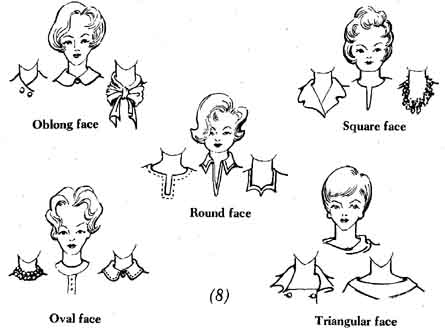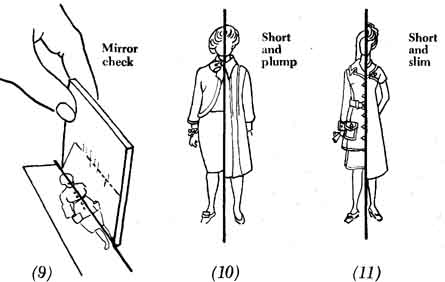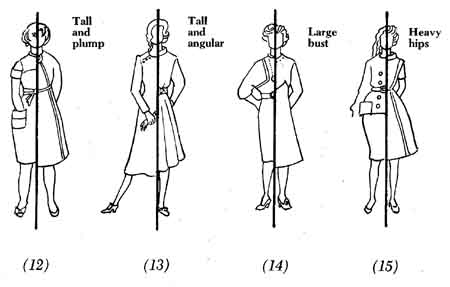The first step toward dressing well is to know yourself — your good points and your had points. The next step is to use the tricks of optical illusions, to use the elements of design, to use the principles of design, and to use the facts of color behavior.
When you look in a full length mirror you see the face and figure with which you were born. Both your face and your figure have good points, also physical defects. The good points are the qualities which you try to stress, and you try to minimize the defects with your make-up, your hair style and your clothes.
FIGURE CHECK
Stand in front of a full length mirror in a bathing suit or tight-fitting pan ties and a brassiere. Take stock of your figure when viewed from the front, from the side, and if possible, from the rear. All views are important if you wish to appear well-dressed to everyone who sees you.
Check the front view and the profile view of your face. Decide on your good and your bad points. Be honest about your bad points.
Study the following list of physical features and characteristics and decide which you believe describe you best.
Face oblong round square oval triangular |
Neck normal long short thin thick |
Arms normal short long thin full |
Shoulders narrow road rounded square sloping |
Bust Small Medium Large High Low |
Waist Length normal long short |
Waistline Small Medium Large |
Abdomen Prominent flat |
Hips Small medium large |
Buttocks flat protruding |
Legs long short thin thick straight curved |
Ankles Thin Medium thick |
Posture Good poor |
Coloring hair skin tone eyes |
|
NECKLINE CHECK
Make the following neckline check to decide which necklines you think are the most becoming to you.
Take pieces of dark colored crepe paper or brown paper that are wide enough to extend over the shoulder, and cut:
(1) a close—fitting round neckline
(2) a high, slight-V neckline
(3) a deep, sharp—V neckline
(4) a close-fitting, square neckline
(5) a deep, square neckline
(6) a high, U-shaped neckline
(7) a low, U-shaped neckline
(8) a bateau or boat-shaped neckline
Try on the different necklines and select the shapes which are most becoming.
Necklines and Hair Styles. The above illustrations show you how the lines of the neckline of a garment and hair styles can alter the apparent shape of your face. (See diagram 8.)

Oblong face. The trick to shortening your face is to have the point of interest tinder your chin: a small collar, a how, or some ornament such as a brooch or button. Your best necklines are high and close. Your next best are those with width. Add width with your hair style.
Round face. Wear your neckline long. Any deep neckline is good for you; a row of buttons marching clown the bodice will help the illusion of length. Never wear a collar that echoes the circle of your face. This applies to hair styles too.
Square face. Soften your jaw line with depth in your neckline: a deep V, a horseshoe neckline, a sweetheart neckline if cut to give the illusion of length.
Oval face. Oval is the ideal shape for faces, so make the most of it. Don’t clutter up your hairdo. You can wear a center part and severe classic styles. Almost any neckline is becoming, but if your neck is thin, keep your neckline high around it.
Triangular face. Your heart-shaped face is at its best above a sweetheart neckline. Any style that brings width to a narrow chin is flattering: the bateau neck, the high cowl, a curved or square neckline that has more width than depth. Bring your hair over your forehead to minimize it.
COLOR CHECK
Collect as many different colors of fabrics, also as many different textures of the same colors, as you can scarves, garments, pieces of fabric — cotton, silk, satin, velvet, crepe.
(1) Hold them under your chin.
(2) Drape them around your neck.
(3) Try them in daylight; try them in artificial light.
Observe the effect of the colors and textures on your skin, your hair and your eyes.
Try the same fabrics on as hats:
(1) with the hairline covered,
(2) with an outline of hair showing.
You will be surprised to discover that you can wear certain colors for a hat which you couldn't possibly wear for a dress; that you can wear certain colors if you have an outline of hair showing. Why?
(1) Your hair forms a break between the color of the fabric and your face.
(2) Colors reflect. A color casts its own reflection downward but brings out its complementary color above. So, a red hat ill give a rosy glow to the face but a red dress will bring out green ill the skin. By this fact of color behavior (colors affect other colors near them), a green hat worn close to the face will reflect a greenish cast on the face but could be very attractive, with certain costumes, worn back of the hairline. A green dress will bring out rosy tones in the skin.
A colored scarf will often make a dress more becoming. A colored hand of fabric around the brim of a hat will make it becoming.
Becoming colors should “do something” for your skin, your hair and your eyes.
Some skins are fine and smooth-grained; others are coarse. Smooth skins have more power to reflect colors than coarse-textured skins. This is why colors which were becoming when you were a child are often less becoming as you get older.
Remember: Complementary colors emphasize and enrich each other. The complementary color combinations are: red and green, blue and orange, yellow and purple. An individual with too much yellow in her skin should not wear purple. Bright green will emphasize a red skin tone, hut very dull green and grayed green could be becoming.
A few general suggestions about colors are: colors should never be conspicuous by themselves but should enhance the wearer; don't wear colors too similar to the color of your skin but, instead, choose those which are warm enough to be harmonious. Avoid tans and grays unless a becoming color is between it and the face — a scarf, collar, beads. Dull colors and dull textures will make a complexion look brighter by contrast. A touch of creamy white near the face will add to the becomingness of dark shades.
If a color is dark enough or dull enough, almost everyone can wear it — or in other words, there is a right shade of every color for every person.
MIRROR CHECK
The following figure types are divided by guide lines. To observe how a style affects the figure, take a purse mirror, about 23 x 3 inches in size. Place the long edge of the mirror exactly on the guide line, holding it at right angles to the page, facing left. The reflection will complete the other half of the figure. Observe how the style makes the most of the figure type. (See diagram 9.)

Reverse the mirror and the reflection will complete the other half of the figure. You will observe how that style isn't suitable for the figure type.
HOW TO CHOOSE CLOTHES to SUIT YOUR FIGURE
Short and Plump
You ought to wear clothes that will make you look taller and slimmer. (See diagram 10 above.)
Choose: Princess lines. Coat-dresses rather than suits, or suits with short jackets. Boleros. Shoulder capes. Vertical tucks and seams and fabrics with vertical stripes. Slightly flared skirts. Dark and medium colors with touches of brightness at the neck-line or in a hat. Narrow center panels. Small all—over prints. Smooth fabrics. Flat, short-haired furs and fur trimmings. Hats carefully chosen to give added height.
Avoid: Tight clothes. Contrasting tops and skirts. Large prints. Bulky fabrics. Frills. horizontal lines. Very full skirts. Large masses of bright colors. Over-padded shoulders.
Short and Slim
Do not exaggerate your smallness, but keep your slim look. (See diagram 11 above.)
Choose: Fitted coats and short fitted jackets. Flared or pleated skirts. Soft woolens. One color costumes. Small, widely-spaced prints. Soft, subtle colors. Small, dainty jewelry. Details on the bodice breast pockets, shoulder trimmings. Accessories and trimmings in proportion to your size — purses, glamour pins, bunches of flowers.
Avoid: Severely-tailored clothing. Long contrasting jackets. Peplums and tiered skirts. Stiff and bulky fabrics. Big prints and plaids. Long-haired furs.
Tall and Plump
You wish to look slimmer and shorter. (See diagram 12.)

Choose: Simple classical lines. Neckline detail. Smooth, chill-textured fabrics. Diagonal lines. A combination of horizontal and vertical lines. Easy fitting silhouettes. Belts in self fabric. Unbroken vertical lines with contrasting side panels. Side closings. Sleeves to camouflage heavy arms. Short, flat furs.
Avoid: Bulky accessories and fussy trimmings. Pleated skirts. Large plaids and large all-over prints. Stiff, shiny or bulky fabrics. Hip fullness. Exaggerated shoulders. Clinging fabrics.
Tall and Angular
If you choose your clothing carefully you can do wonders for yourself. (See diagram 13.)
Choose: Different colors for top and skirt. Loose full coats. Horizontal yokes. Large pockets. Flowing skirts. Plaids. Bold horizontal stripes. Full sleeves. Vivid colors. Stiff, shiny or bulky fabrics. Long-haired furs. Bright colored belts. Large accessories — heavy necklaces, large, wide bracelets, large handbags, large flowers.
Avoid: Fitted coats, low waistlines. Long, tight sleeves. Straight, narrow skirts. Clinging fabrics.
Large Bust
You wish to take away from that top-heavy look. Always consult a full-length mirror and view the figure from the side as well as the front. (See diagram 14.)
Choose: Simple necklines, surplice, diagonal or side closings. Skirts with a slight flare. Upswept lines to hair and hats. Interesting earrings, pins and necklaces that keep the eye well above bust level. Long or three quarter sleeves. Bodices fitted slightly below the bosom to do away with waistline bulk. Dull finished fabrics.
Avoid: Short sleeves that end at bust level. Bright shiny colors. Bulky and box jackets.
Heavy Hips
Concentrate on detail above the waist. (See diagram 15.)
Choose: Interest at neck and shoulder line. Broaden shoulders slightly. Skirt pockets set slantwise. Jackets with well-rounded or slanted front edges. Dull finished fabrics.
Avoid: Jackets or overblouses that end at hip level. Sleeves that end at hip level; sleeves with wide, fancy or contrasting cuffs.
Remember:
- Always consult a full-length mirror.
- Stand up when you buy a hat, to be sure it's in proportion to your figure.
- Texture and color of fabrics also create optical illusions.
- Clinging fabrics reveal the figure.
- Choose accessories suitable to your size, also to the style of your clothing.
- One accent of contrast in accessories is most effective and more elegant — never use more than two notes of accent. Couturier houses call this the Rule of Two.
